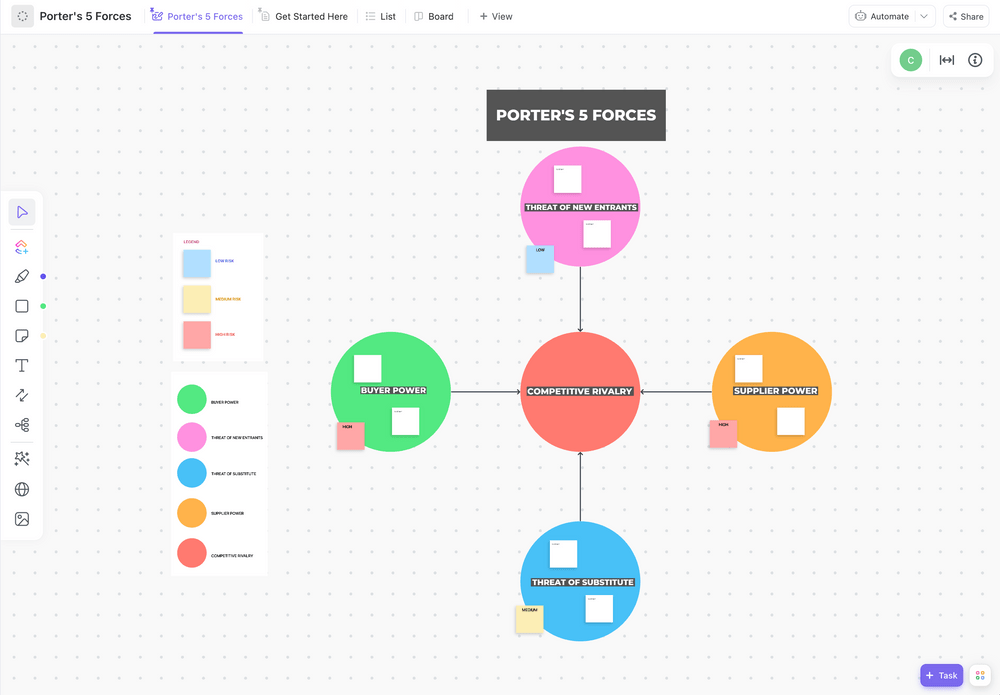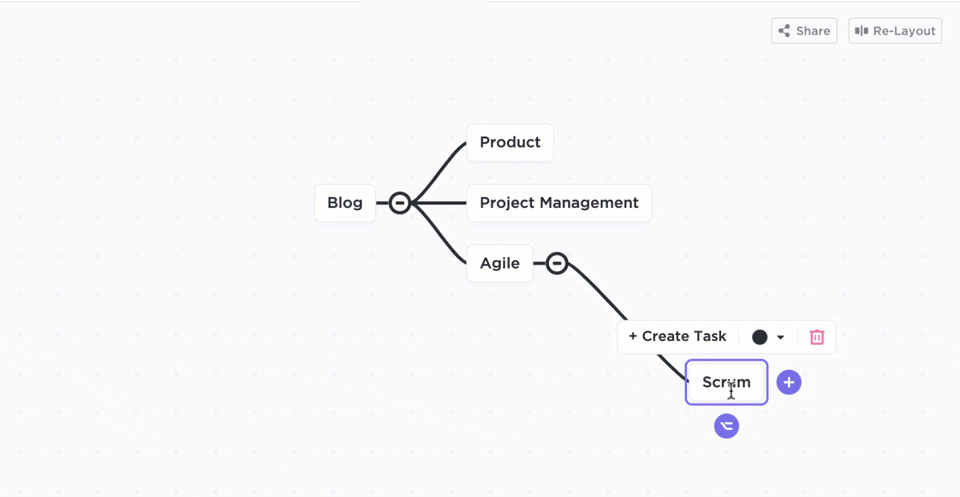Porter’s Five Forces Framework: How to Use It to Build a Competitive Strategy

Sorry, there were no results found for “”
Sorry, there were no results found for “”
Sorry, there were no results found for “”
You’ve probably heard about finding a “blue ocean“—a market where you can be the only player. In reality, though, competition is inevitable, and embracing it can benefit your business in many ways.
Competition is the driving force behind growth and innovation, fostering continuous improvement and promoting accountability and efficiency. Yet, to stand out from the crowd, you must first properly understand your market and the competitive dynamics shaping it. Enter Porter’s Five Forces framework.
Created in 1979 by Harvard Business School professor Michael E. Porter (also known for inventing value chain analysis), this analytical model changed how companies think about competition and planning. It’s not just about looking at your rivals; it’s about considering the bigger picture, including suppliers, customers, new and potential competitors, and alternative products.
In this article, we’ll break down Porter’s Five Forces framework in detail, outlining its essential components and key strengths and downsides. We’ll also show you how to implement the model using ClickUp, a first-class project management and productivity platform.
Porter’s Five Forces framework is a business tool used to understand the competitive dynamics of an industry.
Before the model was created, businesses had focused primarily on internal factors and direct competition. However, Porter challenged this perspective and brought a holistic approach to understanding an industry’s competitive landscape. He shed light on how external competitive forces can significantly impact a company’s profitability and market position.
Porter singled out the following five key factors, or forces, that shape competition:
In other words, even if you think you’re familiar with your current competitors, don’t be too confident that you’ll stay on top of them. A new digital service or other innovation can sneak up on your business when you least expect it and erase your competitive advantage.
Although Porter’s Five Forces and SWOT analysis may look similar, they serve different purposes in strategic planning.
Porter’s Five Forces helps you understand your industry’s competitiveness. It examines external factors to assess the intensity of competition and the market’s profitability.
On the other hand, SWOT analysis offers a broader perspective. It looks inwards and outwards, identifying your business’s strengths, weaknesses, opportunities, and threats.
Let’s say you’re looking to open a new coffee shop in the neighborhood. Porter’s Five Forces model calls for:
This analysis helps you understand how competitive the local coffee market is and whether entering it would be a good idea. ☕
Continuing with the coffee shop example, a SWOT analysis would look at internal strengths and weaknesses as well as external opportunities and threats:
So, while Porter’s Five Forces pushes you to stay ahead of the competition, SWOT analysis helps you maximize your strengths, fix weaknesses, grab opportunities, and deal with threats.
Bonus read: Use the ClickUp SWOT Analysis Template to evaluate your company’s internal strengths and weaknesses, identify external opportunities and threats, and develop strategies for success!

Porter’s 1979 article starts with a simple yet powerful statement:
The essence of strategy formulation is coping with competition.
However, what follows in the next sentence is even more impactful:
Yet it is easy to view competition too narrowly and too pessimistically.
Instead of thinking about competition as a simple contest between existing rivals, Porter introduces four additional aspects to consider: the power of suppliers and buyers, the possibility of new competitors entering the market, and the threat posed by alternative products or services. Let’s closely examine each of the five key factors affecting competition.
According to Porter’s Five Forces framework, competitive rivalry is a key, albeit not the only factor that influences competition within a market. It examines the intensity of competition between direct market rivals.
To determine the level of competition within your industry, first consider the number and relative strength of direct competitors. Next, think about how fast the industry is growing, how expensive it is to exit the market, and how much other companies spend on advertising.
If a market is highly competitive, you can expect price wars, extended periods without a profit, and overly aggressive marketing tactics. On the other hand, a low-competition market presents opportunities for growth and higher profits.
To address these issues, you’ve got to figure out what makes your product special and devise a plan to stand out from the crowd. For example, if you’re selling handmade chocolates in a market full of big brands, you might focus on using organic ingredients or offering unique flavors to attract customers. 🍫
Bonus read: Keep tabs on your competitors’ activities and products with the ClickUp Competitor Tracking Template.

The threat of new entrants force examines the likelihood of new competitors entering your market or industry. Low entry barriers and brand loyalty combined with easy access to distribution channels typically result in a highly competitive market.
Here are some other factors to consider when evaluating the threat of new entrants:
The bargaining power of suppliers refers to the ability of third parties like vendors and equipment providers to impact your competitive position and profitability.
This power is amplified when there are few suppliers and no substitutes or in the case of unique supply products and materials. When suppliers have considerable bargaining power, they can significantly influence prices, product quality and availability, and terms of sale. To mitigate this factor, try to diversify your supplier base or create alternative solutions.
Imagine a small bakery that relies on a single wheat flour supplier. Should that supplier raise prices or compromise on quality, it would dent the bakery’s profits. In order to manage this risk and keep the supplier’s bargaining power in check, the bakery could work with multiple flour suppliers or experiment with alternative ingredients like rye or corn flour. 🥐
The bargaining power of buyers pertains to your customers’ ability to demand lower prices and higher quality of goods and services. Understanding this force helps you innovate your product portfolio to increase customer loyalty, reduce their negotiating power, and maintain a competitive edge.
The buyers’ bargaining power depends on the following factors:
The threat of substitute goods measures the likelihood of consumers switching from your product to an alternative that serves the same purpose or offers the same benefits.
If substitutes are readily available and attractively priced, your competitive position weakens. To mitigate this force, you must innovate, diversify your offerings, and cultivate brand loyalty. Keep a close eye on the latest trends and technological advancements, as these can bring about new substitutes.
Consider a company that manufactures traditional incandescent light bulbs. With the rise of LED technology offering energy-efficient alternatives, consumers may switch to new LED bulbs.
The light bulb company could respond by investing in research to develop its own line of LED bulbs. It might also focus on promoting unique features of its incandescent bulbs, such as warm lighting ambiance or retro designs, to maintain customer loyalty and differentiate itself from LED competitors. 💡
Since his 1979 Harvard Business Review article introducing the concept of five forces, Porter has written several books expanding on his model, most notably On Competition. In it, Porter lays out five simple steps to take for a thorough industry analysis:
Let’s see how to conduct this analysis and create strategies to outsmart industry competition using ClickUp, the leading project management and productivity platform.
Understanding and tackling the challenges of a competitive environment is much more manageable with a template for implementing Porter’s Five Forces framework. We specifically recommend the ClickUp Porter’s 5 Forces Template.

This template is a valuable tool that lets you shed light on the looming threats and document the size and relative influence of your direct rivals, suppliers, and buyers. It gives you an easy-to-use Whiteboard view with various real time collaboration features. The template enables you to visualize Porter’s five forces using five color-coded circles:
Each section helps you assess competitive forces, making it clear how they impact your business. You can even rate the intensity of each force as Low, Medium, or High risk, adding depth to your analysis.
Managers find this ready-made framework especially useful for identifying market opportunities and threats, maintaining or increasing market share and profitability, positioning products for long-term success, and conducting gap analyses for process improvements.

If you find the ClickUp Porter’s Five Forces Template and other Whiteboard-based templates too limiting, you can always start from scratch and build your own ClickUp Whiteboard.
Use these infinite digital canvases to brainstorm with your team and collaboratively determine the five forces shaping your competitive landscape. You can use all kinds of shapes and objects to depict your best ideas and draw connections between them.
Moreover, you can turn any element on the Whiteboard into a task with a single click, thus bridging the gap between ideation and execution. This functionality helps you not only identify and visualize the five forces in your industry but also develop strategies for gaining and maintaining a competitive edge.

ClickUp Mind Maps is another excellent tool for conducting Porter’s Five Forces analysis. The mind mapping technique lets you easily map out and draw connections between the forces in your industry using drag-and-drop nodes.
Businesses in competitive industries ranging from software development and marketing to construction and healthcare can all use Porter’s Five Forces model to understand specific problems and craft winning strategies in their respective markets.
By systematically analyzing each of the five forces, companies can evaluate the feasibility of entering new markets, developing new products and services, or forming strategic alliances.
They can also determine the threat level presented by new market entrants, existing rivals, or substitute products—and create appropriate product differentiation, innovation, and positioning strategies.
Let’s illustrate the process and the benefits of applying Porter’s Five Forces model using a specific, real-life example.
If you run a real estate company, you’d start applying Porter’s Five Forces by defining the exact “industry” or niche you want to analyze. For example, it could be constructing and selling luxury condominiums in New York City. 🏗️
You’d start by identifying and counting the key players dealing with high-end real estate properties in and around NYC. If you did so, you’d realize that competitive rivalry in this industry is alive and well. In addition, the bargaining power of buyers also seems to be pretty high at the moment, given that there are more luxury condos than people looking to purchase them.
And considering how long it takes to obtain the material for constructing condominiums and the relative scarcity of construction workers, suppliers’ bargaining power is also on the higher end of the spectrum.
On the other hand, it’s not easy to build and sell high-end property in NYC—you need experience in dealing with regulators and a stellar reputation and track record to prosper in this field. Likewise, there’s hardly a realistic alternative for someone looking for a luxury condo in NYC, making the threat of substitutes extremely low.
The result of the analysis: It’s probably not a good idea to venture into the business of constructing and selling high-end real estate in NYC without prior experience or reputation. The entry barriers are high and the niche is dominated by a few well-established players.
The Porter’s Five Forces model is a strategic tool designed to give you a clear, analytical insight into your competitive landscape. It is, however, not without its limitations and drawbacks, as you’ll see in the table below: 👇
| Strengths | Limitations |
| The model is user-friendly and relatively simple to understand and apply It provides a comprehensive overview of the competitive dynamics by considering not just rivals but also suppliers, buyers, new entrants, and substitutes It guides strategic decision making by helping you understand the competitive dynamics and profitability in your industry It is a powerful tool for diagnosing your organization’s competitive position It’s incredibly versatile; it can be applied to any industry, regardless of size or complexity | The model assumes a classic perfect market, which doesn’t exist in reality It’s static and doesn’t account for the dynamics of the market or industry trends It doesn’t fully consider the impact of digital transformation or technological innovations, which are crucial in today’s digital world It doesn’t take into account the synergies that can emerge from strategic alliances or partnerships It overlooks the influence of other external factors, such as government regulations, social changes, or economic conditions |
Porter’s Five Forces model helps you better understand your competition and guides you on where to focus your efforts and investments for sustained growth. By studying how things operate in the supply chain and investing in research and development, you can find ways to stand out from industry competitors.
With its handy templates and collaborative tools like Whiteboards and Mind Maps, ClickUp makes the process of applying Porter’s Five Forces model easy for businesses of all sizes and industries. Sign up today to see the platform in action—it’s free.
© 2025 ClickUp